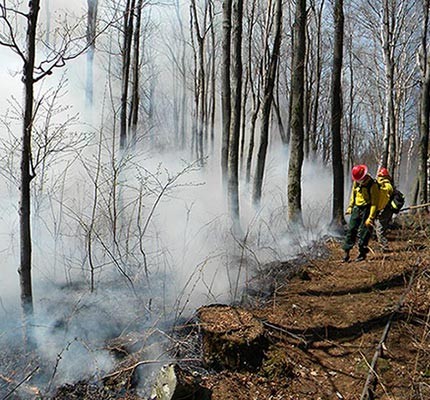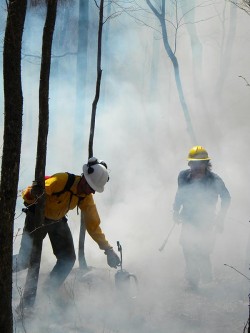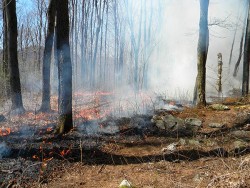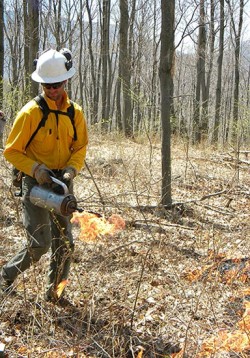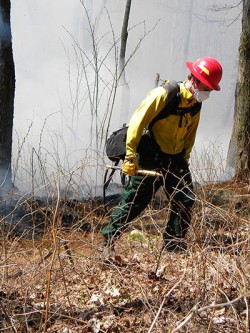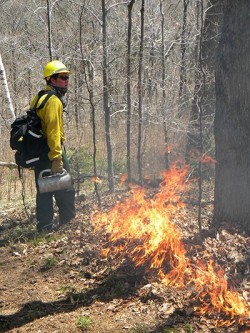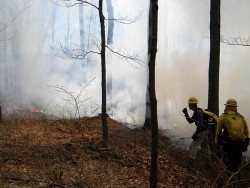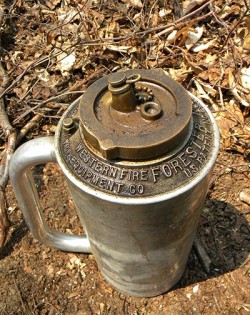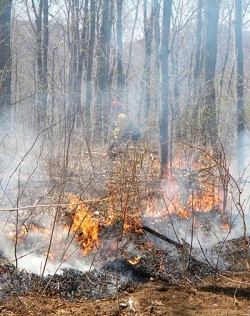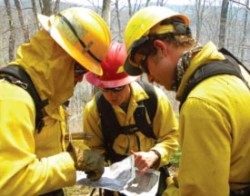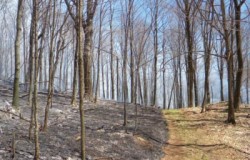Last year, May first was about as nice a spring day as you could ask for. Dawn broke cool, maybe a touch of frost in the cold spots, but the sky was high – just blue jay blue – and it was warming up fast.
Up on a hillside in Rupert, Vermont, Thomas “Nort” Phillips, his colleague Silos Roberts, and about 12 other hired hands were starting a forest fire. The team had arrived the day before to do the prep work: poring over the burn site, noting topography and terrain, busting up piles of slash that might burn too hot, and hacking and leaf blowing a five-foot-wide firebreak around the perimeter of the 60-acre management unit. Most had camped out and were now assembled on the uphill side of the property, getting ready to light the first match and push the fire down into the valley.
The workers wore yellow jackets and carried backpacks full of water or powder expellant. Safety helmets. Radios. Day packs. Many wore kerchiefs around their noses and mouths like outlaws from the Wild West, though instead of six-shooters they carried shovels and fire rakes and McLeod tools. One wielded a wand nozzle hooked to a length of hose that ran to a water tank in the back of a UTV.
Phillips gave the word, and the men in front spread out and started dropping globs of flame onto the forest floor with drip torches. The sun-baked duff lit instantly and a light breeze spread the flame. At first there was a stark demarcation, as the smoke and fire proceeded from the bare fire break in a perfect orderly fashion. But then the wind swirled, and smoke blew back, and suddenly everything was white.
Phillips started Fire Management Services with partners Silos Roberts and Rick Redin in 1993, after working for decades as a fire management officer with the U.S. Forest Service. “We were always hearing from private forestland owners, or non-profits, who were saying: ‘I’ve got oak, or pine, and I’ve got this problem. How can I do a controlled burn?’” Phillips said. “And at that point, there just wasn’t anybody in the private sector doing this sort of work. I recognized the opportunity to broaden the use of prescribed fire in the Northeast, and I took it.”
This underuse of fire has roots in federal policy – specifically the “10 a.m. Policy,” instituted by the Forest Service in 1926, which mandated that all fires be extinguished before 10:00 on the morning following their first report. This reflected the thinking of the time that all forest fires represented unacceptable threats. Conservationists started publicly questioning the policy in the 1960s, but it wasn’t until 1995 that the Forest Service officially recognized fire as a “critical natural process.” By then, several generations of Americans had grown up thinking of fire as a plague, not a silvicultural tool.
“Until fairly recently, the culture in New England and New York was for total suppression,” said Phillips. “What’s interesting is that a lot of the burns we’re doing today, especially out in western New York, are designed to encourage fire-adapted natural communities, which exist because Native Americans used to do a lot of burning in those areas.”
Today, Fire Management Services works with landowners to conduct prescribed burns around the Northeast. This could mean a shrubland habitat burn in Connecticut designed to help New England cottontails, a regeneration burn in a commercial lowbush blueberry patch in Maine, or a forest burn in southern Vermont to discourage beech. Fire can also be used to promote certain tree and plant species and to help control some invasives.
Estimating the cost is difficult, since every job is so different.
“We have to look at the site,” said Phillips. “In a woodland setting maybe you’re looking at $300 an acre, but to give you something firm I have to figure out logistics, the control line, general strategy. If it’s a volatile area, the price is going to reflect this.”
Permitting can be another complicating factor. “We turned down a phragmites control job in New York City recently because the politics just got too cumbersome. There were a dozen city agencies to go through to get permits – it just got too complex.”
Back on the job site in Rupert, there was a sense of ordered chaos, the workers’ yellow slickers glowing amidst a heavy blanket of smoke. The goal was a fire that was hot enough to reduce the organic material on the forest floor and kill the thinned-skinned beech trees that were dominating the understory, but not intense enough to kill the mature trees in the stand, which included some nice hard maple – a species not known for its fire tolerance. That’s why Nort and company set the fire in spring, when the duff was dry but the soil temps low and the water table high. To help keep things from getting too hot, about a third of the crew was on mop-up duty, spraying down slash, smashing out pockets of lingering fire with shovels and rakes. They worked in a seemingly post-apocalyptic landscape where everything smoked and hissed.
Another third of the crew was taming the fire: guarding the line, radios buzzing constantly, shouts emerging from the haze. “Get up to those two maples! There’s shit behind you, too, so watch out.” Guys scampered back and forth, congregating at the trouble spots where the fire had hopped the firebreak to beat or rake it out.
The rest of the crew kept advancing the front, receiving updates from behind that the fire was in control; waiting for word from their flank before applying more flame so the line advanced in an even fashion.
Phillips presided over it all in an energetic, jocular manner. He has the gray ponytail of an aging hippy but talks like a cross between a football coach and a biology professor. The crew was this same mixture of tough and smart. They used phrases like mucociliary transport and cuss words in the same sentence. Some were professional forest firefighters who later that summer would be fighting the big fires out West. Others were parttimers with day jobs, but they get together to conduct burns a few times a year. The company is a member of the National Wildfire Suppression Association, and all the workers are required to complete a number of training and physical certification requirements and renew those certifications annually.
The first match was lit around 9 a.m., and the crew worked until one o’clock the next morning on account of an unexpected wind that kept the fire going. That next day, anyone walking the woods road that traces the west line of the burn unit would have been astounded at the sight: everything to the east was black and harsh; everything to the west was brown and soft. The fire followed the road so perfectly it was as if an artist had painted on the char. I asked one of the foresters affiliated with the burn when they might see results, and he said in May or June of this year. Five to seven years from now the verdict will really be in.
Fire Management Services has two forest fires booked for this spring, with more in the planning stages. “This is the best job in the world,” Phillips told me when we first met. “We get paid to start fires and then we get paid to put them out.”
Wagner Forest Management, Ltd. is pleased to underwrite Northern Woodlands’ series on forest entrepreneurs.


